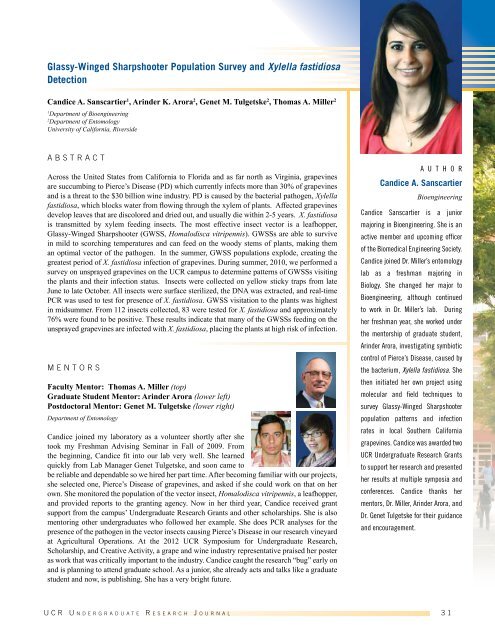Undergraduate Research Journal
Undergraduate Research Journal
Undergraduate Research Journal
Create successful ePaper yourself
Turn your PDF publications into a flip-book with our unique Google optimized e-Paper software.
Glassy-Winged Sharpshooter Population Survey and Xylella fastidiosa<br />
Detection<br />
Candice A. Sanscartier 1 , Arinder K. Arora 2 , Genet M. Tulgetske 2 , Thomas A. Miller 2<br />
1<br />
Department of Bioengineering<br />
2<br />
Department of Entomology<br />
University of California, Riverside<br />
ABSTRACT<br />
Across the United States from California to Florida and as far north as Virginia, grapevines<br />
are succumbing to Pierce’s Disease (PD) which currently infects more than 30% of grapevines<br />
and is a threat to the $30 billion wine industry. PD is caused by the bacterial pathogen, Xylella<br />
fastidiosa, which blocks water from flowing through the xylem of plants. Affected grapevines<br />
develop leaves that are discolored and dried out, and usually die within 2-5 years. X. fastidiosa<br />
is transmitted by xylem feeding insects. The most effective insect vector is a leafhopper,<br />
Glassy-Winged Sharpshooter (GWSS, Homalodisca vitripennis). GWSSs are able to survive<br />
in mild to scorching temperatures and can feed on the woody stems of plants, making them<br />
an optimal vector of the pathogen. In the summer, GWSS populations explode, creating the<br />
greatest period of X. fastidiosa infection of grapevines. During summer, 2010, we performed a<br />
survey on unsprayed grapevines on the UCR campus to determine patterns of GWSSs visiting<br />
the plants and their infection status. Insects were collected on yellow sticky traps from late<br />
June to late October. All insects were surface sterilized, the DNA was extracted, and real-time<br />
PCR was used to test for presence of X. fastidiosa. GWSS visitation to the plants was highest<br />
in midsummer. From 112 insects collected, 83 were tested for X. fastidiosa and approximately<br />
76% were found to be positive. These results indicate that many of the GWSSs feeding on the<br />
unsprayed grapevines are infected with X. fastidiosa, placing the plants at high risk of infection.<br />
Mentors<br />
Faculty Mentor: Thomas A. Miller (top)<br />
Graduate Student Mentor: Arinder Arora (lower left)<br />
Postdoctoral Mentor: Genet M. Tulgetske (lower right)<br />
Department of Entomology<br />
Candice joined my laboratory as a volunteer shortly after she<br />
took my Freshman Advising Seminar in Fall of 2009. From<br />
the beginning, Candice fit into our lab very well. She learned<br />
quickly from Lab Manager Genet Tulgetske, and soon came to<br />
be reliable and dependable so we hired her part time. After becoming familiar with our projects,<br />
she selected one, Pierce’s Disease of grapevines, and asked if she could work on that on her<br />
own. She monitored the population of the vector insect, Homalodisca vitripennis, a leafhopper,<br />
and provided reports to the granting agency. Now in her third year, Candice received grant<br />
support from the campus’ <strong>Undergraduate</strong> <strong>Research</strong> Grants and other scholarships. She is also<br />
mentoring other undergraduates who followed her example. She does PCR analyses for the<br />
presence of the pathogen in the vector insects causing Pierce’s Disease in our research vineyard<br />
at Agricultural Operations. At the 2012 UCR Symposium for <strong>Undergraduate</strong> <strong>Research</strong>,<br />
Scholarship, and Creative Activity, a grape and wine industry representative praised her poster<br />
as work that was critically important to the industry. Candice caught the research “bug” early on<br />
and is planning to attend graduate school. As a junior, she already acts and talks like a graduate<br />
student and now, is publishing. She has a very bright future.<br />
A U T H O R<br />
Candice A. Sanscartier<br />
Bioengineering<br />
Candice Sanscartier is a junior<br />
majoring in Bioengineering. She is an<br />
active member and upcoming officer<br />
of the Biomedical Engineering Society.<br />
Candice joined Dr. Miller’s entomology<br />
lab as a freshman majoring in<br />
Biology. She changed her major to<br />
Bioengineering, although continued<br />
to work in Dr. Miller’s lab. During<br />
her freshman year, she worked under<br />
the mentorship of graduate student,<br />
Arinder Arora, investigating symbiotic<br />
control of Pierce’s Disease, caused by<br />
the bacterium, Xylella fastidiosa. She<br />
then initiated her own project using<br />
molecular and field techniques to<br />
survey Glassy-Winged Sharpshooter<br />
population patterns and infection<br />
rates in local Southern California<br />
grapevines. Candice was awarded two<br />
UCR <strong>Undergraduate</strong> <strong>Research</strong> Grants<br />
to support her research and presented<br />
her results at multiple symposia and<br />
conferences. Candice thanks her<br />
mentors, Dr. Miller, Arinder Arora, and<br />
Dr. Genet Tulgetske for their guidance<br />
and encouragement.<br />
U C R U n d e r g r a d u a t e R e s e a r c h J o u r n a l 3 1














